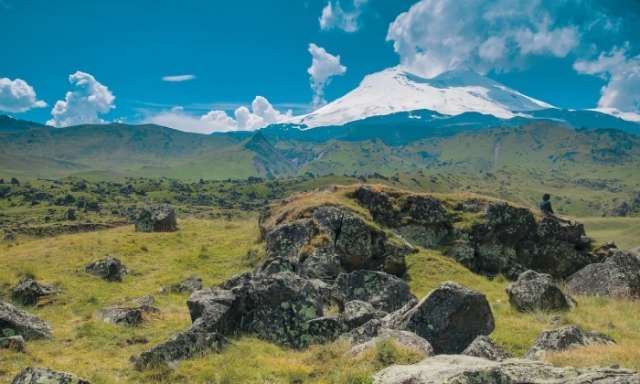On that 2004 journey, I was sleeping on a village bench when some men approached. One, Gocha, insisted I stay with him. When we got to his house, out came a bottle of vodka. When it was empty, out came another one. He wouldn’t let me leave for three days! Eventually I climbed out of the window and did a runner. When I went back 13 years later, he immediately said: “Ah, Englishman.” And then, of course, he opened another bottle …

Traditional Georgian khachapuri bread.
That hospitality was what drew me back. Georgians have a saying: “A stranger will never die of hunger.” The food is amazing: my favourite dish was khachapuri, Georgian cheesy bread that’s great with local wine. I slept in all kinds of places: shepherds’ caves, locals’ floors and the odd hotel. One memorable place was a cave that turned out to be an ancient tomb – I’d slept among the old graves.
The landscape is very diverse, but it’s the cultural diversity that really stands out. One valley will be Christian, the next Muslim, and there are more than 50 ethnic groups – Dagestan alone has about 35. I started my journey in April, when it was -40C in the mountains. By the time I got to Iran in July, it was 45C! May and June are lovely times to go, as is early autumn.

Mud volcano at Gobustan in Azerbaijan.
The most dangerous part was trying to climb Mount Elbrus in southern Russia. It’s Europe’s highest mountain at 5,642 metres; I got to 4,900 metres and had to turn back in hurricane-strength winds. The most magical moment was waking up in Azerbaijan’s Gobustan desert, a world heritage site with 6,000 rock engravings, and gazing at the mud volcanoes through the mist.

Nariqala Fortress and the Abanotubani quarter, Tbilisi.
Anyone could do this journey, or at least part of it. Georgia and Azerbaijan have comfortable hotels but don’t see many western tourists: you could go on a two-week holiday and not see a single one. In certain parts of Russia and Iran, you have to accept that you will be followed by the secret police or given a government minder. In Russia I was trailed by the FSB (the former KGB).
If you only visit one city in the Caucasus, make it Tbilisi, capital of Georgia. It is an incredible place that has come on in leaps and bounds in the past decade. There are historic sites such as Narikala fortress, and a hipster quarter where you can get a nice coffee. You can take day trips into the mountains and go skiing at Gudauri.

Tabriz, old bazaar, Iran
It was fascinating to see how technology has changed lives in Iran. The government can try to ban Facebook and Twitter, but people find a way around it. They go to parties and on dates – society is opening up. For traditional shopping, you can’t beat Tabriz, one of Iran’s former capitals. It has the biggest covered bazaar in the world, and is the place to buy Persian rugs, jewellery, spices and much more.
After the Chechen wars in the 1990s, Grozny, the capital, was bulldozed and started again from scratch. Today, it looks like Dubai. I stayed in the five-star Grozny City hotel, which opened in 2011 – a place like that was unthinkable in 2004.
The original article was published in the Guardian.
More about: #Caucasus
















































